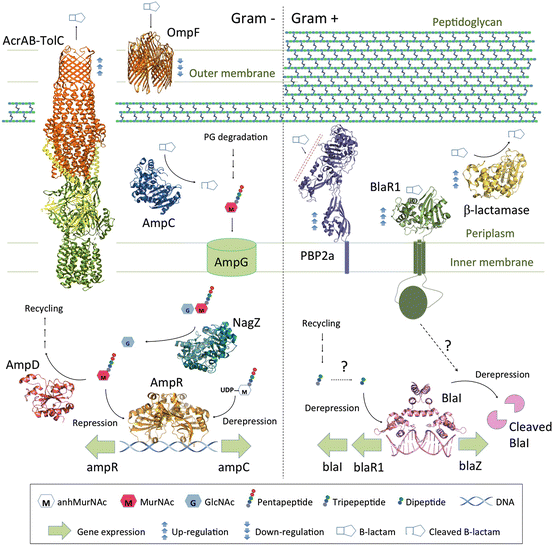

Release of Peptidoglycan Fragments Into the Milieu

coli has proteins covalently attached to the PG such as Braun’s lipoprotein (Lpp), whereas GC and MC do not have proteins covalently attached to PG ( Wolf-Watz et al., 1975). This modification controls the function of lytic transglycosylases (LTs) and serves to limit PG degradation by host lysozyme ( Blundell et al., 1980 Rosenthal et al., 1982). Neisseria have O-acetylation at the C6-hydroxyl on about 50% of the MurNAc residues ( Rosenthal et al., 1982). There are two significant differences between Neisseria PG and that of E. The peptide chains in the intact cell wall are mostly tetrapeptides (75%) or tripeptides (25%), with dipeptides and pentapeptides making up a small fraction ( Dougherty, 1985).

meningitidis cell wall does not contain Dap–Dap crosslinks ( Antignac et al., 2003b), but more recent experiments indicate that Dap–Dap crosslinks occur in both N. Crosslinks are also formed between meso-Dap on one strand and meso-Dap on the other strand. The crosslinks are formed between the fourth amino acid D-Ala on one strand and the third amino acid meso-Dap on the other for a majority of the crosslinks. gonorrhoeae, approximately 40% of the peptides are crosslinked to peptides on adjacent PG strands to form the cell wall, although there is some variation in the degree of crosslinking between strains ( Rosenthal et al., 1980). Peptides are attached to the MurNAc and consist of two to five amino acids of the sequence L-Ala- D-Glu- meso-Dap- D-Ala- D-Ala ( Figure 1). The glycan strands are composed of repeating β-(1,4)-linked disaccharides of GlcNAc-β-(1,4)-MurNAc. meningitidis, known as gonococci (GC) and meningococci (MC), the PG composition is highly similar to that seen in Escherichia coli and many other Gram-negative bacterial species ( Dougherty, 1985 Glauner et al., 1988 Antignac et al., 2003b).

However, the structure of Neisseria PG is not unusual. During gonococcal infections, these released PG fragments induce an inflammatory response in the human host that causes tissue damage in the Fallopian tubes and may exacerbate the pathology of urethral, uterine, and disseminated infections. The pathogenic Neisseria attracted the attention of peptidoglycan (PG) researchers due to the propensity of these bacteria to release small PG fragments during growth ( Rosenthal, 1979 Sinha and Rosenthal, 1980). Peptidoglycan (PG) Structure in Neisseria Overall, we describe the processes involved in PG degradation and recycling and how certain characteristics of these proteins influence the interactions of these pathogens with their host. meningitidis as well as normal cell size. Also, deacetylation of PG was required for virulence of N. Endopeptidases and carboxypeptidases were found to be required for type IV pilus production and resistance to hydrogen peroxide. A number of additional PG-related factors affect other virulence functions in Neisseria. Gonococcal AmpG was found to be slightly defective compared to related PG fragment permeases, thus leading to increased release of PG. Another major factor for PG fragment release is the allele of ampG. The localization of two of these proteins was demonstrated to affect PG fragment release.
PBP3 NEISSERIA FREE
coli were found free in the periplasm or in the cytoplasm. gonorrhoeae PG degradation proteins were demonstrated to be in the outer membrane while their homologs in E. coli, the pathogenic Neisseria have far fewer PG degradation proteins, and some of these proteins show differences in subcellular localization compared to their E. Examination of the mechanisms of PG degradation and recycling identified proteins required for these processes. It is not yet known if PG fragment release contributes to the highly inflammatory conditions of meningitis and meningococcemia caused by N. meningitidis also releases pro-inflammatory PG fragments, but in smaller amounts than those from N. gonorrhoeae these PG fragments are known to cause damage to human Fallopian tube tissue in organ culture that mimics the damage seen in patients with pelvic inflammatory disease. Neisseria gonorrhoeae and Neisseria meningitidis release peptidoglycan (PG) fragments from the cell as the bacteria grow.


 0 kommentar(er)
0 kommentar(er)
